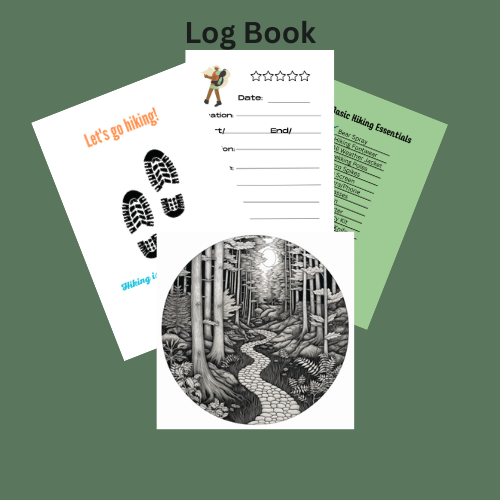Hiker’s Log Book, What Are The Benefits
A hiker’s log book can offer several benefits to both the hiker and the hiking community. There are many Digital Logbooks apps out there but there are drawbacks. Tangible logbooks can be convenient for hikers who enjoy the tactile experience of writing and want to have a physical keepsake of their hiking adventures.
A memorable keepsake to pass down to your future generation.
Here Are Some Advantages Of Maintaining A Hiker’s Log Book:
- Memories and Reflection: Hiker’s Log Book allows hikers to record their experiences, thoughts, and emotions during their hikes. It serves as a personal diary and a way to capture memories of specific trails, beautiful vistas, encounters with wildlife, and other notable experiences. It can also serve as a tool for reflection and personal growth, allowing hikers to look back on their progress and achievements over time.
- Trip Planning: Log books can be valuable when planning future hikes. By recording details about the trails, such as difficulty level, terrain, distance, and notable landmarks, hikers can refer back to their logbook for guidance and insights when planning future trips. It helps in making informed decisions about the trials to explore based on personal preferences and capabilities.
- Trail Conditions and Updates: Hikers can use logbooks to note the current conditions of the trails they have hiked. This information can be helpful for fellow hikers, as well as for park rangers, trail maintenance teams, and other authorities responsible for trail upkeep. By sharing observations about trail conditions, hikers contribute to the collective knowledge of the hiking community and help ensure the safety and enjoyment of future hikers.
- Community Engagement: They can foster a sense of community among outdoor enthusiasts. When logbooks are made publicly accessible, whether physically at trailheads or online platforms, hikers can share their experiences, recommendations, and tips with others. It creates an opportunity for hikers to connect, learn from one another, and engage in discussions about hiking destinations, gear, and techniques.
- Conservation and Research: A Hiker’s Log Book can play a role in environmental conservation and research efforts. Hikers can use their logs to document observations of wildlife, plant species, and ecological changes they encounter during their hikes. This data can contribute to scientific research, wildlife monitoring, and conservation initiatives, aiding in understanding and protecting natural habitats.
- Level of Difficulty: Easy, Medium, Hard. I like to add it to my notes as posted ratings are inaccurate depending on health, experience, and fitness level.
What Information Data Is In A Hiker’s Log Book
A hiker’s logbook typically contains a variety of information and data related to their hiking experiences. Here are some common elements found in a logbook:
- Date: The date of the hike helps keep track of when each hike occurred.
- Trail Name and Location: The name and location of the trail or hiking route provide a reference for the specific area explored.
- Trail Description: A description of the trail, including its length, difficulty level, terrain characteristics, and notable features, helps hikers recall the trail’s unique attributes.
- Weather Conditions: Recording the weather conditions, such as temperature, precipitation, wind, and visibility, helps hikers and future readers understand the environmental factors that may have influenced the hike.
- Distance and Duration: The total distance covered and the time taken for the hike can be noted to track personal progress and estimate future hike durations.
- Elevation: The total elevation gained during the hike provides insights into the trail’s steepness and intensity.
- Points of Interest: Noting significant landmarks, viewpoints, waterfalls, wildlife sightings, or other noteworthy features encountered along the trail adds depth to the hiking experience.
- Trail Conditions: Hikers can record the conditions of the trail, including any obstacles, maintenance issues, or hazards encountered. This information can be valuable for future hikers and trail maintenance organizations.
- Personal Notes: Hikers often include personal reflections, thoughts, and observations about the hike, such as their emotions, highlights, challenges, and lessons learned. These notes contribute to the individual experience and can serve as a source of inspiration or learning.
- Gear and Equipment: Some hikers may choose to log the gear and equipment they used during the hike, such as backpacks, footwear, clothing, and any specific hiking or camping gear they found useful.
- Hiking Companions: If hiking with others, hikers can mention the names or initials of their companions, fostering a sense of shared experiences.
- Photographs or Sketches: Some log books may include space for attaching or drawing photographs or sketches of the scenery, landmarks, or wildlife encountered during the hike.
Remember, the specific content and format of a hiker’s log book can vary based on personal preferences and the intended purpose of the logbook. The key is to include information that is meaningful to the hiker and can enhance the hiking experience.
My Favorite Log Book For Hiking
The Hiking Adventure Log Book can be found at Amazon.ca or at Amazon.com below. It also comes with a list of a few beneficial hiking essentials if one is unsure what to carry in a backpack.
6×9 Log Books are conveniently portable, making them ideal for backpacks, allowing you to jot down noteworthy experiences during your hike. They also make great gift ideas for any hiker of all ages.
“I like ones with a lot of entries so I can log my well over 100 hikes in 2 yrs”

This Wildlife Coloring Book is a great addition if you love wildlife and the outdoors.








Thanks for sharing! It’s practical not only for factual info but also I like how you suggested recording your thoughts and feelings during the hike. Great idea!
Thank You